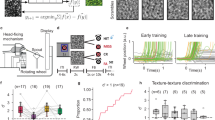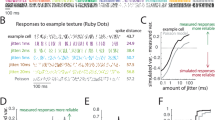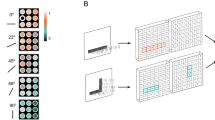Abstract
The visual environment is perceived as an organized whole of objects and their surroundings. In many visual cortical areas, however, neurons are typically activated when a stimulus is presented over a very limited portion of the visual field, the receptive field of that neuron1,2,3,4. To bridge the gap between this piecewise neuronal analysis and our global visual percepts, it has been postulated that neurons representing elements of the same object fire in synchrony to represent the perceptual organization of a scene5,6,7,8,9,10. Experiments with stimuli such as moving bars or gratings have provided evidence for this hypothesis11,12,13,14,15,16. We have further tested this by presenting monkeys with various textured scenes consisting of a figure on a background, and recorded neuronal activity in the primary visual cortex (area V1). Our results show no systematic relationship between the synchrony of firing of pairs of neurons and the perceptual organization of the scene. Instead, pairs of recording sites representing elements of the same figure most commonly showed equal amounts of synchrony between them as did pairs of which one site represented the figure and the other the background. We conclude that synchronin V1 does not reflect the binding of features that leads to texture segregation.
This is a preview of subscription content, access via your institution
Access options
Subscribe to this journal
Receive 51 print issues and online access
$199.00 per year
only $3.90 per issue
Buy this article
- Purchase on Springer Link
- Instant access to full article PDF
Prices may be subject to local taxes which are calculated during checkout




Similar content being viewed by others
References
Hubel, D. H. & Wiesel, T. N. Receptive fields and functional architecture of monkey striate cortex. J.Physiol. (Lond.) 195, 215–243 (1968).
Hubel, D. H. & Wiesel, T. N. Ferrier lecture: functional architecture of macaque monkey visual cortex. Proc. R. Soc. Lond. B. 198, 1–59 (1977).
Schiller, P. H., Finlay, B. L. & Volman, S. F. Quantitative studies of single cell properties in monkey striate cortex I–V. J. Neurophysiol. 39, 1288–1374 (1976).
Maunsell, J. H. R. & Newsome, W. T. Visual processing in monkey extrastriate cortex. Annu. Rev. Neurosci. 10, 363–401 (1987).
Milner, P. M. Amodel for visual shape recognition. Psychol. Rev. 81, 521–535 (1974).
von der Malsburg, C. & Schneider, W. Aneural cocktail-party processor. Biol. Cybern. 54, 29–40 (1986).
Eckhorn, R. et al. Coherent oscillations: a mechanism for feature linking in the visual cortex? Biol. Cybern. 60, 121–130 (1988).
Engel, A. K., König, P., Kreiter, A. K., Schillen, T. B. & Singer, W. Temporal coding in the visual cortex: new vistas on integration in the nervous system. Trends Neurosci. 15, 218–226 (1992).
Singer, W. Synchronization of cortical activity and its putative role in information processing and learning. Annu. Rev. Physiol. 55, 349–374 (1993).
Singer, W. & Gray, C. M. Visual feature integration and the temporal correlation hypothesis. Annu. Rev. Neurosci. 18, 555–586 (1995).
Gray, C. M., Engel, A. K., König, P. & Singer, W. Oscillatory responses in cat visual cortex exhibit intercolumnar synchronization which reflects global stimulus properties. Nature 338, 334–337 (1989).
Engel, A. K., König, P. & Singer, W. Direct physiological evidence for scene segmentation by temporal coding. Proc. Natl Acad. Sci. USA 88, 9136–9140 (1991).
Kreiter, A. K. & Singer, W. Stimulus dependent synchronization of neuronal responses in the visual cortex of awake macaque monkey. J. Neurosci. 16, 2381–2396 (1996).
Livingstone, M. S. Oscillatory firing and interneuronal correlations in squirrel monkey striate cortex. J. Neurophysiol. 75, 2467–2485 (1996).
Freiwald, W. A., Kreiter, A. K. & Singer, W. Stimulus dependent intercolumnar synchronization of single unit responses in cat area 17. Neuroreport 6, 2348–2352 (1995).
Brosch, M., Bauer, R. & Eckhorn, R. Stimulus dependent modulations of correlated high-frequency oscillations in cat visual cortex. Cerebral Cortex 7, 70–76 (1997).
Lamme, V. A. F., van Dijk, B. W. & Spekreijse, H. Texture segregation is processed by primary visual cortex in man and monkey. Evidence from VEP experiments. Vision Res. 32, 797–807 (1992).
Lamme, V. A. F., van Dijk, B. W. & Spekreijse, H. Contour from motion processing occurs in primary visual cortex. Nature 363, 541–543 (1993).
Lamme, V. A. F. The neurophysiology of figure-ground segregation in primary visual cortex. J. Neurosci. 15, 1605–1615 (1995).
König, P., Engel, A. K., Roelfsema, P. R. & Singer, W. How precise is neuronal synchronization? Neur. Comput. 7, 469–485 (1995).
Ts'o, D. Y., Gilbert, C. D. & Wiesel, T. N. Relationships between horizontal interactions and functional architecture in cat striate cortex as revealed by cross-correlation analysis. J. Neurosci. 6, 1160–1170 (1986).
Gilbert, C. D. & Wiesel, T. N. Columnar specificity of intrinsic horizontal and cortico-cortical connections in cat visual cortex. J. Neurosci. 9, 2432–2442 (1989).
Malach, R., Amir, Y., Harel, M. & Grinvald, A. Relationship between intrinsic connections and functional architecture revealed by optical imaging and in vivo targeted biocytin injections in primate striate cortex. Proc. Natl Acad. Sci. USA 90, 10469–10473 (1993).
Krüger, J. & Aiple, F. The connectivity underlying the orientation selectivity in the infragranular layers of monkey striate cortex. Brain Res. 477, 57–65 (1989).
Gilbert, C. D. & Wiesel, T. N. Clustered intrinsic connections in cat visual cortex. J. Neurosci. 3, 1116–1133 (1983).
Gilbert, C. D. Circuitry, architecture and functional dynamics of visual cortex. Cerebral Cortex 3, 373–386 (1993).
Lamme, V. A. F., Zipser, K. & Spekreijse, H. Figure–ground activity in primary visual cortex is suppressed by anesthesia. Proc. Natl Acad. Sci. USA 95, 3263–3268 (1988).
Bour, L. J., van Gisbergen, J. A. M., Bruijns, J. & Ottes, F. P. The double magnetic induction method formeasuring eye movement — results in monkey and man. IEEE Trans. Biomed. Eng. 31, 419–427 (1984).
van der Togt, C., Lamme, V. A. F. & Spekreijse, H. Functional connectivity within the visual cortex of the rat shows state changes. Eur. J. Neurosci. 10, 1490–1507 (1998).
Acknowledgements
We thank W. Singer, P. Roelfsema, K. Zipser and C. Van der Togt for comments on an earlier version of the manuscript; K. Brandsma and J. de Feiter for biotechnical support; and P. Brassinga and H. Meester for technical support. This work was supported by a grant from the Royal Netherlands Academy of Arts and Sciences (KNAW) to V.A.F.L.
Author information
Authors and Affiliations
Corresponding author
Rights and permissions
About this article
Cite this article
Lamme, V., Spekreijse, H. Neuronal synchrony does not represent texture segregation. Nature 396, 362–366 (1998). https://doi.org/10.1038/24608
Received:
Accepted:
Issue Date:
DOI: https://doi.org/10.1038/24608
This article is cited by
-
Top-down influences on visual processing
Nature Reviews Neuroscience (2013)
-
A novel, jitter-based method for detecting and measuring spike synchrony and quantifying temporal firing precision
Neural Systems & Circuits (2012)
-
Spectral fingerprints of large-scale neuronal interactions
Nature Reviews Neuroscience (2012)
-
Synchrony and covariation of firing rates in the primary visual cortex during contour grouping
Nature Neuroscience (2004)
-
Multiplexing using synchrony in the zebrafish olfactory bulb
Nature Neuroscience (2004)
Comments
By submitting a comment you agree to abide by our Terms and Community Guidelines. If you find something abusive or that does not comply with our terms or guidelines please flag it as inappropriate.



